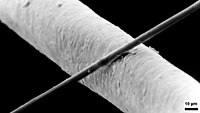
Photo from wikipedia
Full factorial designs are conducted to identify the effects of the incorporation of microparticles of silica, Portland cement and carbon laminate wastes (carbon microfibres (CMF)), at 3, 6 and 9… Click to show full abstract
Full factorial designs are conducted to identify the effects of the incorporation of microparticles of silica, Portland cement and carbon laminate wastes (carbon microfibres (CMF)), at 3, 6 and 9 wt% levels, on the mechanical performance of epoxy polymers and single carbon fibre joints at two grammage levels (200 and 600 g/m2). Particulate reinforced polymers (PRP) are characterised in tensile, compression, three-point bending and impact tests to better assess the influence of particles in the interlaminar region of hybrid composites composed of fibres and particles. The single joint test is performed to verify the presence of shear locking effect using particles between laminae. Compressive strength and modulus of PRPs increase when 3 wt% CMFs are added, revealing the most efficient level. The apparent shear strength is higher in composite joints made with 600 g/m2 grammage and CMF particles, promising reinforcement mechanisms for hybrid composites.
Journal Title: Journal of Composite Materials
Year Published: 2022
Link to full text (if available)
Share on Social Media: Sign Up to like & get
recommendations!